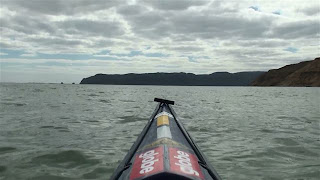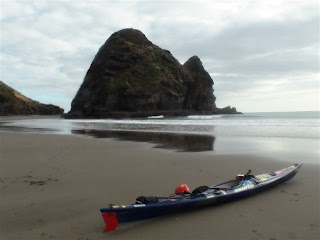Day 119, Mar 26 2010
Before I began my preparations I sent a text message to Emma at the Raglan Chronicle regretting the fact that I’d missed her unexpected visit yesterday whilst stating that I was departing this morning. Speaking into my camera I was anything but enthused about the day ahead. It was another grey day that hinted at more rain. The fresh south-wester did nothing to perk me up even though it offered hope that Port Waikato, some 65km distant, might just be within reach.
Getting ready.
I had a chance meeting with Derek, a local resident who I’d come across climbing out of his kayak a couple of days earlier, just as I was climbing into my own kayak. He was on his bike and introduced me to his cycling partner on this dour morning, David. David it turned out was from the Chronicle. This association explained to me how the local newspaper had become aware of my presence. It was nearing 9:30am and with a potentially long day ahead of me I had just enough time to say goodbye, but not before brushing off their concerns regarding the conditions posed by the bar. I’d conducted a reconnaissance of the conditions from the beach the day before. My perception had been that despite the 4.0 metre swell showing up on the weather maps it was not overly apparent over the bar.
On the way.
The outgoing tide was in full flow and it was not long before I passed through the harbour entrance. I stuck to a deep channel that was about 40 metres wide carrying me out to sea being at a good rate. I was struck by how choppy it was here, but noting the surf either side of me, believed that this confirm my impressions from the day before.
Approaching the harbour entrance.
My confidence was soon eroded however when I noted previously unseen waves directly in my path with no obvious route to avoid them. It didn’t matter that I ceased paddling. The strong current had cut down the distance between me and the newly perceived threat in a devastatingly short amount of time and I was caught by surprise when a wave suddenly appeared in front of me where before there had been none.
I knew that I was in trouble as soon as I saw it. I was upside down again, and could only fumble for the handle that allowed me to extricate myself from the upturned kayak in the now turbulent waters. So unexpected had this turn of events been that the camera had still been on deck, and running at the time! It was my immediate thought when my head broke the surface.
I turned the kayak over and noted, not surprisingly, that it was no longer attached to the deck. I took hold of the safety line to which I hoped it was still attached and gathered it in. I was unsure as to what I would find on the end of it so it was with an enormous sense of relief that I discovered both the camera and mount still attached… and running!

I knew I was in trouble as soon as I saw it.
I was very conscious of not letting the kayak be swept from my grip as had recently occurred to me on arriving at Marokopo. On this occasion I was a lot further out to sea and did not have the camera packed away. I also had the paddle to think of. It too was attached to the kayak by a line, but how well this would hold up to the forces applied to it, was a risk I preferred not to test.
About to hit.
I put one end of the paddle inside the flooded cockpit, took the camera’s strap between my teeth, and hugged and gripped the kayak’s cockpit rim with all my strength as wave after wave began battering us. With each wall of foam that hit, my grip on the kayak was threatened. I felt myself dragged through the water as each new wave attempted to tear the kayak from my grip.
I had no idea how long this would last. I was a long way from the shore and I wondered whether the current might still carry me out beyond the waves that continued to batter me. Worse still, might one cancel the other? Would the current carry me back out to the waves that had just pushed me in some way?
In trouble.
At one point in time, with a slight lull between waves, knowing that there was nought to do but ride it out, I actually turned the camera back on, although it was only for a short while as it took one hand away from the kayak and I could barely hold on with two. I took the very next opportunity to open one of the bulkheads and secure the camera in it before the next wave hit.
Worry, or is that fear?
I may not have been frightened, but I was worried. Very worried. I was in a situation that I was not sure I could escape from. Were there people watching me from the shore? The sight of me doing nothing but hanging onto the kayak half-a-kilometre from shore as wave after wave pounded me would no doubt raise concerns. From my perspective I simply held on in the hope that either the waves or the current would win out and thereby offer me an opportunity to take some steps of my own. It would not have surprised me in the slightest at this point if I’d heard the sound of a helicopter above me.
This wave passed me by... just.
I’m not sure how many waves I had to ride out. On at least half-a-dozen occasions I was forcibly dragged after the kayak, submerged in the wave, only stopping when that same wave gave up its hold on the half-submerged vessel. I finally sensed a change in the water. Was I back in the channel where the water was again deeper?
I had to get back to shore. I switched the water pump on, but each and every bit of chop simply washed over the hull topping up the flooded cockpit as quickly as it emptied. My only option was to climb into the craft that was extremely unstable in its flooded condition and secure the skirt to stop it refilling.
I’d managed to climb aboard and point the bow to the shore - it was still hundreds of metres away - when a swell rose behind me causing the kayak’s bow to dig deep and cause another capsize. I’d not had time to secure the skirt so it was no problem to quickly right the kayak and try again.
On this occasion I was able to secure the skirt whilst the pump continued to try to make an impression on the huge amount sharing the cockpit with me. I thought I was in for another repeat when another swell picked up the kayak and drove me down its face but on this occasion the kayak maintained its course with the bow pointing straight and true.
It was in fact the most exhilarating ride I’d ever had and not only because it was carrying me towards safety. For well over a hundred metres the kayak surfed towards the shore on a beautiful unbroken swell. I had never travelled so far, so quickly. I was no more than thirty metres from the shore when it finally dissipated.
I’d thought to myself that the trip might be over when I was out there, but now that I was back on the beach I was even more determined to finish. This was one of my very first thoughts. It was of course because of the relief that I was feeling, but I was in better spirits now than I had been whilst I was preparing to begin earlier in the morning.
I mopped up the final remnants of my drama from the cockpit and walked the kayak inside the mouth of the harbour. I could see from here just how strong the current was and there was no way I could have paddled against it.
Funny, but hugging the shore as I paddled back towards where I’d started from, I noted and enjoyed immensely the interesting and picturesque shoreline. I’ve no doubt that a river or lake would have been a far less taxing challenge. I’d say “next time”, however I’ve a feeling that my kayaking days won’t endure much past the completion of this journey.

Wow, much better!
 Whose idea was it to tackle the ocean anyway?
Whose idea was it to tackle the ocean anyway?
When I finally stopped paddling I immediately ran up the street towards the offices of the Raglan Chronicle. I had a story to tell!
Note: I would note later using the camera that the time of the capsize was 9:58am. When I finally climbed back into the cockpit and turned on the camera it was 10:55am. By my estimation, allowing for the time between reaching the beach and then climbing back in, it took me nearly forty five minutes after the capsize to get back to the safety of the shore. An appraisal of the bar from a high vantage point a few days later suggested to me that the waves I'd encountered were nearly one kilometre from the shore.
Video of the incident (Raglan I, II, & III), can be accessed by the "CHECK THESE LINKS OUT!" component of the blogsite.




















































